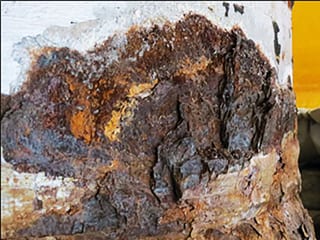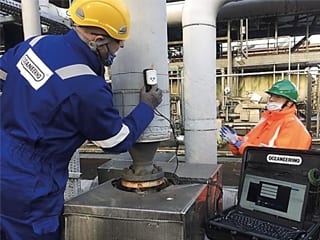Following on from the very successful lunchtime webinar series covering Pipeline Coatings, Linings and Cathodic Protection Safety Considerations, with MCF, the branch held its annual joint technical meeting with the Energy Institute (EI) on 26 January 2021 on the theme of, Corrosion Under Insulation – why are we still talking about this?
There were three excellent speakers for this Event – Rebecca Allison (OGTC– Oil and Gas Technology Centre), Yvonne Onuegbu (EI AHI – Energy Institute Aberdeen Highlands and Islands) and Jim McNab (OIS – Oceaneering International Services).

Rebecca Allison, Head of Emissions Reduction at OGTC.
Rebecca Allison discussed the results from a recent survey by Corrosion Radar which showed that over 95% of the O&G Industry felt that management of Corrosion under insulation (CUI) was not currently adequate, and should be up-dated or radically transformed. She noted some industry facts identified in the survey:
- CUI incurs 40 – 60% of the process plant maintenance costs within the UK Continental Shelf (UKCS), and costs the UK £28 billion every year |rising to an estimated £4 trillion globally.
- CUI is one of the major causes of accidents in the oil and gas industry,
since 1984, out of 137 major oil and gas accidents reported within the
EU, over 20% have been associated with CUI.

Corrosion under Insulation, an ongoing Issue.
The key components of a CUI strategy are Prediction, Monitoring and Detection:
- Prediction using data & digital analytics for continuous monitoring to identify where it will occur.
- Monitoring using sensors to detect moisture and early signs of corrosion using retrofitted and cost-effective instrumentation on Late Life and Brownfield Sites.
- Detection deploying automated and efficient inspection techniques, although there is a need to push for more investment in new technologies.
A goal was set 4 years ago by OGTC to eliminate all CUI failures in Oil and Gas fields by 2026 but so far it cannot be said that any significant progress toward this goal has been made. OGTC welcomed the resurrection of the industries CUI Forum with Henrik Andersen, Materials, Corrosion & Inspection Lead at Shell UK Limited as its chair, and which hopefully as an industry, new ways of working and use of Management of Change (MOC) to push through new technologies can be found.

Yvonne Onuegbu (Energy Institute Aberdeen Highlands and Islands).
Yvonne Onuegbu briefly explained CUI as the external corrosion of pipework and vessels that occurs beneath insulation following ingress of water and corrosive contaminants. There are several Industry guidelines and recommended practices which have been developed, the most prominent being: API RP 583 – CUI and Fireproofing, NACE SP0198 -2017, EFC WP13 WP15, and EI Guidelines for Design, installation and management of Thermal Insulations systems.
CUI presents so many challenges due to the many factors and parameters involved namely, temperature, moisture and contaminants, plus inspection techniques, maintenance requirements and cost. For temperature alone, carbon steel suffers issues from -4C to 175C (mainly in the range, 30 -120C) and for CRA materials between 20C and 200°C, commonly manifesting in the form of chloride stress corrosion racking and/or localised chloride pitting (unless well coated). The moisture or water can be from rainfall, steam discharge, condensation or sweating. Contaminants increase the corrosiveness of the water which comes mainly from the surrounding atmospheric / marine environment, and are often trapped within the insulation materials themselves.
About 20% of pipework failure and maintenance costs since 1994 are due to CUI, so there is good justification to pursue solutions. When trying to investigate CUI the external condition of the cladding can indicate obvious issues if it is disturbed or broken but often intact insulation has to be removed to investigate and reveal corrosion beneath the covering, which has been indicated by other detection techniques, leaks or alarms. Non-intrusive methods of inspection (NII) such as Radiography (RAD), Long Range Ultrasonic Testing (LRUT), Pulsed Eddy Current (PEC) and Guided Wave UT, may be used but they all have their limitations, detection capability, varying speed and cost, with sometimes inconsistent results and individual interpretation issues. RAD in particular can be a slow and hazardous operation requiring scaffolding and containment of the test areas. LRUT is more of a screening tool to indicate general areas where insulation should be stripped off, and (PEC) will detect gross defects but is not so good on minor defects.
Yvonne summarised that for effective management of CUI, the process can be broken down into a structured approach of, investigation, analysis, assessment and mitigation. The assessment process must prioritise the areas considering critical and historical data to focus programmes of work according to the probability of failure followed by Insulation removal, either full or partial.
The CUI Mitigation Strategy involves defining the inspection scope, evaluation technique, and periodicity of inspection and coverage. This stepped approach summarises current industry thinking.

Jim McNab, (Oceaneering International Services).
Jim McNab then described Focused Stress Concentration Tomography (FSCT) which is a specialised inspection technique for insulated pipelines and being developed by Spier Hunter Ltd in association with Oceaneering with funding from OGTC. The new technology stems from an existing SCT technology whereby an operator wears the inspection tool and walks over the known line of buried pipeline while in operation. It is magnetometer based and it ‘absorbs’ or listens to the magnetic field changes around localised flaws and interprets them as Stress Concentration Zones (SCZ’s). Off-line analysis of the collected data shows SCZ location, severity, pipeline route and depth of burial. FSCT is a ‘blinkered’ version of traditional SCT technology designed to focus the magnetometers and shield them from external magnetic influences. The objectives of this technology are quick screening and real time data interpretation.
A case study showed the evaluation of an un-piggable pipeline which had identified localised high stress concentration zones. DCVG coating inspection also indicated local coating defects. The corrosion under the coating was revealed to have spread some 10m along the pipe past the defect. The FSCT Probe can be mounted on a pipe using a bracelet frame or used as a hand-held unit which is guided over a marked grid by the operator in axial or circumferential directions on pipes in any orientation. This has so far been tested on 4” to 20” diameter samples along with a 5m diameter pressure vessel, and on insulation thickness up to 65mm.

FSCT Probe in use on thermally insulated gas piping.
The newly developed probe is ruggedised to IP65 and has been tested in operational O&G environments at Flotta Terminal in Orkney and St Fergus Gas Plant installation near Peterhead, but still requires extended data gathering analysis in order to develop algorithms based on real CUI examples, refine the technique, and gain assurance. Future objectives are therefore to determine the limitations of the technology, in terms of maximum insulation thickness, possible stand-off of the probes, and determining how different insulation materials or jacket types influence the results.



